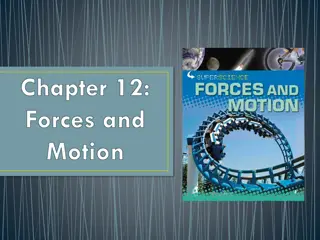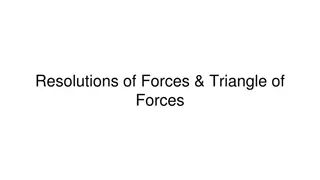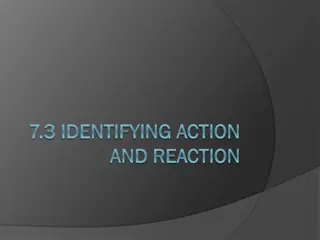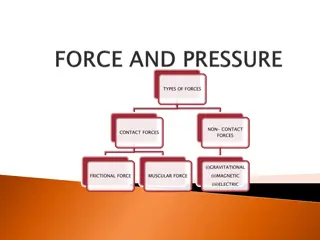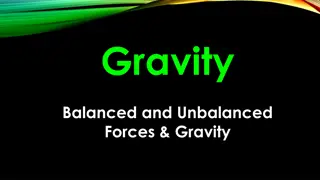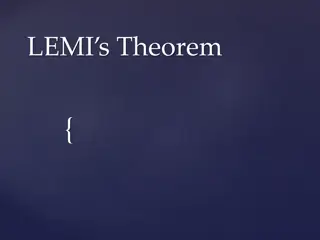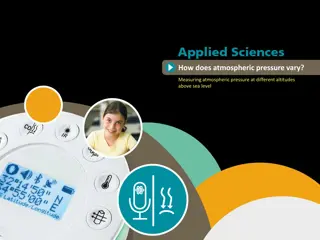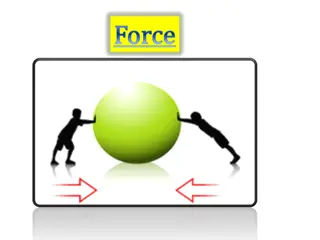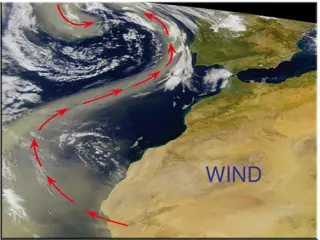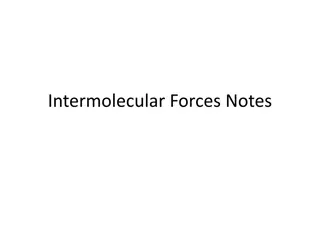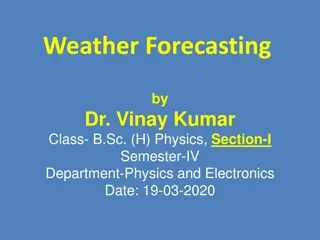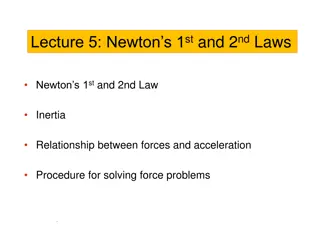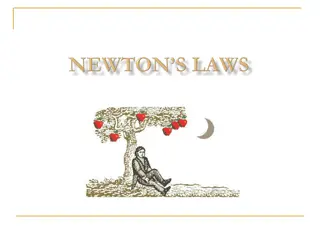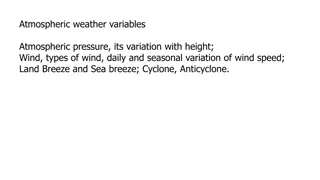Forces and Motion in Physics
Exploring the concepts of forces and motion, this content delves into the fundamental aspects of how forces impact objects' movement. Covering topics such as measuring force, representing force as a vector, combining forces through addition and subtraction, and understanding balanced and unbalanced
3 views • 61 slides
The Horse-Cart System: Forces and Acceleration Explained
The Horse-Cart problem delves into the dynamics of forces acting on a horse pulling a cart, highlighting the importance of net forces, accelerations, and external interactions with the ground. The analysis simplifies the complex system by focusing on key forces impacting the cart's movement and the
2 views • 17 slides
Resolutions and Triangle of Forces in Physics
Resolutions of forces involve breaking down a force into components, while the Triangle of Forces explores how forces interact in equilibrium. By analyzing graphical and mathematical representations, you can determine the resultant force and its direction using trigonometric functions. Applying the
1 views • 11 slides
Geopotential and Geopotential Height in Atmospheric Thermodynamics
Explore the concept of geopotential and geopotential height in atmospheric sciences, focusing on their significance in understanding gravitational and centrifugal forces on Earth. Learn about the definition, calculation, and applications of geopotential height in relation to atmospheric properties a
1 views • 14 slides
Action and Reaction Forces in Physics
Explore the concept of action and reaction forces in physics through examples like a falling boulder and interactions between different masses. Understand how forces are equal and opposite, leading to accelerations based on mass and force interactions. Discover the relationship between Earth and the
0 views • 16 slides
Different Types of Forces and Their Applications
This content explores various types of forces including non-contact and contact forces such as gravitational, magnetic, electric, frictional, and muscular forces. It also discusses the effects of forces on different surfaces and provides examples of force application in real-life scenarios.
1 views • 10 slides
Arc Forces in Welding: Gravity and Surface Tension Forces
Explore the significance of arc forces in welding, focusing on gravity and surface tension forces. Learn how these forces impact metal transfer, deposition efficiency, and welding quality. Discover the role of gravitational force in detachment and transfer of molten metal, and how surface tension fo
5 views • 25 slides
Coplanar Forces and their Classification
Coplanar forces are forces that lie in the same plane and can be classified into concurrent, parallel, non-concurrent, and non-parallel systems. These forces can be reduced to a single force or a couple for analysis. Understanding these force systems is essential in engineering and physics to determ
3 views • 20 slides
Central and Non-Central Forces in Physics
Newton's laws of motion introduced the concept of forces, leading to the classification of fundamental forces like gravitational, electromagnetic, strong nuclear, and weak nuclear forces. Central forces act toward or away from a fixed center, while non-central forces are affected by additional param
1 views • 7 slides
Van der Waals Forces and Intermolecular Interactions
Van der Waals forces encompass London dispersion forces, dipole-dipole forces, and hydrogen bonding, influencing interactions between atoms and molecules. London dispersion forces are the weakest and present in all molecules, dipole-dipole forces involve permanent dipoles, and hydrogen bonding, the
0 views • 9 slides
Forces in Physics
Explore the concept of forces in physics, including definitions, measurement units, combining forces, and their effects on objects' motion. Learn about balanced and unbalanced forces, net force, force pairs, directions, magnitude, and how to combine forces at right angles. Develop a solid understand
1 views • 24 slides
Gravity and Balanced/Unbalanced Forces in Physics
Explore the fundamental concepts of gravity and balanced/unbalanced forces in physics. Gravity is the force that pulls objects toward each other, acting universally. Balanced forces maintain object stability, while unbalanced forces can cause motion changes based on direction, strength, and mass. Di
0 views • 9 slides
Forces in Mechanics: Fundamentals and Applications
Prof. Madhuri Reddy, an Assistant Professor at Hope Foundation's International Institute of Information Technology, explains the characteristics of forces, systems of forces, and the concept of resultant force and composition of forces in mechanics. Forces are defined as agents that produce or destr
0 views • 11 slides
Lami's Theorem in Physics
Lami's Theorem is an equation that explains how the magnitudes of forces acting on a point keep an object in equilibrium. This theorem relates the forces with corresponding angles and is derived by understanding the sum of forces acting on a point. By utilizing complementary angles and the sine rule
0 views • 8 slides
Atmospheric Pressure Variations at Different Altitudes
Atmospheric pressure varies with altitude due to the weight of the air column above. This activity explores how Otto von Guericke's experiments with vacuum systems demonstrate the power of air pressure. Theoretical concepts of atmospheric pressure are discussed, highlighting its relation to gravity
1 views • 28 slides
Forces Applied at an Angle on Inclined Planes
Exploring the concept of forces applied at angles other than 90 degrees on inclined planes, the process involves resolving forces into component vectors, finding net forces in each direction, writing force equations (Fnet = ma), and solving for normal force and acceleration in practical scenarios li
0 views • 28 slides
Forces in Motion: A Comprehensive Overview
Forces play a crucial role in our daily activities, influencing motion and direction. This chapter delves into the concept of forces as pushes or pulls, exploring balanced and unbalanced forces and their impact on velocity. By examining real-life scenarios like kicking a soccer ball or opening a doo
1 views • 10 slides
Balanced and Unbalanced Forces in Physics
Forces play a crucial role in determining an object's motion. Balanced forces have a net force of 0 N, resulting in no change in motion, while unbalanced forces lead to a change in motion. Inertia, the resistance to changes in motion, and the concept of combining forces are also important in underst
3 views • 30 slides
Forces and Mass
Forces, such as contact and non-contact forces, interact with objects to cause motion or deformation. Mass is the amount of matter in an object, measured in kilograms. Learn about applied force, normal force, frictional force, air resistance, spring force, tensile forces, compressive forces, and she
1 views • 29 slides
Cutting-Edge Atmospheric Chemistry Modeling Research at Barcelona Supercomputing Center
Conducted by the Atmospheric Composition Group at Barcelona Supercomputing Center, this cutting-edge research focuses on atmospheric chemistry modeling using advanced tools and frameworks like HERMESv3 and MONARCH. The team's approach integrates various modules to study complex processes influencing
0 views • 16 slides
Forces and Dynamics in Atmospheric Science
Exploring the forces acting on parcels of air in the atmosphere, including gravitational acceleration, pressure gradient acceleration, and viscosity. Delving into Lagrangian and Eulerian derivatives, advection, and transforming to a rotating frame with Coriolis effect. Enhance your knowledge of atmo
0 views • 14 slides
Overview of Low-Cost Sensors for Atmospheric Composition Measurement
This publication provides an insightful overview of low-cost sensors for measuring atmospheric composition, covering topics like sensor technologies, applications in atmospheric sciences and air quality management, and evaluation methods. It emphasizes the importance of not only the technical perfor
0 views • 17 slides
Atmospheric Forces and Their Impacts on Weather
Explore the intricate relationship between wind patterns, hydrostatic balance, pressure gradient forces, Coriolis forces, and their effects on atmospheric dynamics. Discover how these key forces interact to shape weather patterns around the globe, from wind direction to air parcel movement and press
1 views • 45 slides
Force Diagrams and Balanced/Unbalanced Forces
Explore the concepts of force diagrams, balanced forces, and unbalanced forces through visual examples and explanations. Learn how balanced forces keep objects stationary or at a constant speed, while unbalanced forces cause movement and changes in direction. Practice calculating resultant forces an
1 views • 11 slides
Forces: Effects of Multiple Forces on Objects
Exploring the impact of multiple forces on objects through scenarios involving friction, pushing, and pulling. Students investigate the role of gravity and analyze how different forces influence the movement or stability of objects. The lesson includes hands-on activities and discussions to deepen u
1 views • 10 slides
Intermolecular Forces: Strength, Types, and Examples
Intermolecular forces are attractions between molecules, weaker than chemical bonds. They include London dispersion forces, dipole-dipole interactions, and hydrogen bonding. Strength varies, with covalent bonds being the strongest and London dispersion forces the weakest. Different types of intermol
2 views • 15 slides
Wind Patterns and Forces in Weather Forecasting
Wind plays a crucial role in weather forecasting, with different types of winds such as local, vertical, zonal, and meridional affecting atmospheric conditions. Forces like Pressure Gradient Force and Coriolis Force influence wind direction and speed. This article explores the science behind wind pa
0 views • 16 slides
Intermolecular Forces and Dispersion Forces in Molecules
Particle diagrams of liquids, solids, and gases reflect distinct arrangements due to intermolecular forces. The existence of substances as gases, liquids, or solids at room temperature is attributed to the forces between molecules known as intermolecular forces (IMF), with dispersion forces being th
0 views • 30 slides
NSF Atmospheric Chemistry Program Overview
The NSF Atmospheric Chemistry Program aims to characterize the chemical composition of the atmosphere, understand chemical processes, quantify fluxes of chemical substances, study natural and anthropogenic causes of variability, and assess impacts on climate. The program supports research through pe
0 views • 6 slides
Newton's Laws of Motion: Inertia, Forces, and Acceleration
Delve into the fundamentals of Newton's first and second laws of motion, exploring concepts such as inertia, the relationship between forces and acceleration, and the procedure for solving force problems. Discover how objects behave when left to themselves, and grasp the significance of forces in ch
0 views • 21 slides
Atmospheric Composition and Structure
The presentation covers fundamental concepts related to the Earth's atmosphere, including its composition, origin of oxygen, dry and moist layers, standard atmosphere layers, and temperature variations. Key topics discussed include the primordial atmosphere, atmospheric constituents, water vapor dis
0 views • 58 slides
Forces and Equilibrium in Physics
Forces in physics can be categorized into contact forces and field forces, measured in units like Newtons (N). Inertia, mass, weight, and equilibrium are fundamental concepts in understanding the behavior of objects under different conditions. An object in motion stays in motion unless acted upon by
0 views • 15 slides
Atmospheric Pressure, Wind Variations, and Humidity in Weather Systems
The atmosphere is composed of various elements like gaseous molecules, water vapor, and dust particles. Key weather variables include atmospheric pressure, temperature, humidity, wind, cloud cover, and precipitation. Atmospheric pressure is influenced by the weight of air above a point, with average
1 views • 17 slides
Forces and Their Applications
Forces are pushes or pulls that can cause objects to speed up, slow down, change direction, or shape. They are measured in newtons (N) using a newtonmeter. Various types of forces include contact, tension, electrostatic, friction, and gravitational forces. Forces always occur in pairs, with equal an
1 views • 46 slides
Forces Edition of Who Wants to Be a Millionaire?
Test your knowledge about forces with this interactive quiz show styled as "Who Wants to Be a Millionaire? Forces Edition." Answer questions ranging from the types of forces, units of measurement, gravity, and static objects. Enjoy the challenge and see how much you know about the forces around us.
0 views • 61 slides
Teachings for Exercise 7B
In this exercise, you will explore the application of forces in equilibrium scenarios involving tension, weight, and other forces. Through detailed calculations and diagrams, you will learn how to determine tensions in strings, weights of beads, and forces acting on masses in various configurations.
0 views • 6 slides
Magnetic Effects: Exploring Fields and Forces
Delve into the fascinating world of magnetic effects, where fields interact with charges to produce forces. Understand the behavior of magnets when cut, the creation of magnetic fields by electric currents, and the forces exerted on moving and stationary charges. Discover the SI unit for magnetic fi
0 views • 14 slides
Future Changes in Atmospheric Rivers in Norway
Research investigates future trends in atmospheric rivers and extreme precipitation in Norway. Findings show increasing frequency and intensity of atmospheric rivers in the Far-Future, particularly during summer, with winter precipitation rising on the mid- and south-west coasts. Utilizing data obse
0 views • 13 slides
Understanding Forces in Atmospheric Circulation
This presentation explains the forces associated with different wind patterns in atmospheric circulation. It covers the geostrophic wind over Arkansas, gradient wind over Kentucky, and surface wind over Lake Huron. The forces include pressure gradient force (PGF), Coriolis force (COR), centrifugal f
0 views • 10 slides
Understanding Atmospheric Sciences Course: Winter 2023
Gain an understanding of synoptic systems, dynamical concepts, and weather forecasting in the Atmospheric Sciences 370 course for Winter 2023 with Cliff Mass and Rick Steed. Explore the structure and evolution of weather phenomena, developing essential skills in atmospheric analysis and forecasting
0 views • 6 slides
